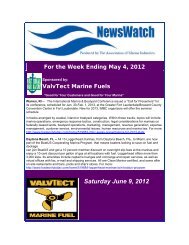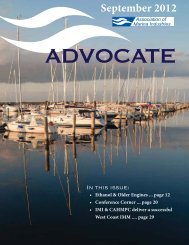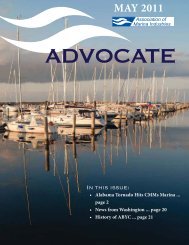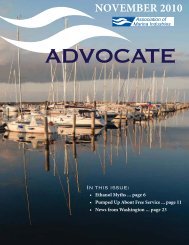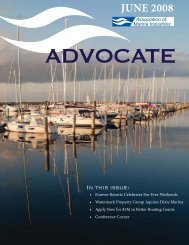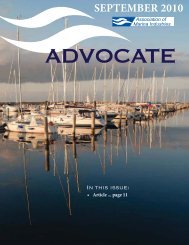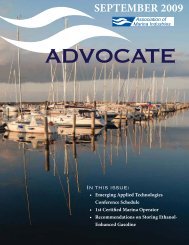asin water surface areas required for berths <strong>of</strong> various lengths. A single berthfor a 30 foot power boat requires a total area <strong>of</strong> 960 square feet, including thewater area in the berth, the fairway in front <strong>of</strong> the berth, <strong>and</strong> the main walkway<strong>and</strong> fingerfloat deck areas that define the berth. However, a single berth for a60 foot powerboat requires a total area <strong>of</strong> 2,628 square feet, more than 2.7times the required area <strong>of</strong> the 30 foot berth (see Table B-7). The utilization <strong>of</strong>sub-meters removes the cost <strong>of</strong> electrical power from the inequitable berthlength/area equation, identifies actual power consumption, allocates costs to theactual users, <strong>and</strong> encourages significant savings <strong>of</strong> electrical power <strong>and</strong> moneyfor both marina operators <strong>and</strong> their customers.Sub-metering will also result in a decrease in fire hazards by encouraging boaters tounplug or turn <strong>of</strong>f unattended/unnecessary heaters, lights, air conditioners,refrigerators, freezers, trash compactors, battery chargers, radios, TVs, computers,<strong>and</strong> other power equipment <strong>and</strong> devices.Another positive impact <strong>of</strong> sub-metering is the potential increase <strong>of</strong> the effectivecapacity <strong>of</strong> older electrical systems on existing marinas. Aging marinas experiencethe growing dem<strong>and</strong> for more power as more electrically dem<strong>and</strong>ing boats occupythe berths. Marinas that allow liveaboards <strong>and</strong> overnight/weekend occupation <strong>of</strong>berthed boats experience increased power dem<strong>and</strong>s. This results in a growingfrequency <strong>of</strong> circuit breaker tripping, maintenance, repair <strong>and</strong>/or replacement. Theinstallation <strong>of</strong> sub-meters has an immediate impact on the boater’s perspective onthe cost <strong>of</strong> power <strong>and</strong> its impact on their wallets. Typically, wasteful use <strong>of</strong> power isgreatly reduced, making capacity available to meet legitimate increases in dem<strong>and</strong><strong>and</strong> extending the useful life <strong>of</strong> existing electrical systems.In <strong>California</strong>, prior to 1993, only private marinas could install <strong>and</strong> operate submeters.However, Assembly Bill 2108, signed into law on October 11, 1993,specifically allowed public marinas to sub-meter as well. Along with this legalapproval came the requirement to comply with rules <strong>and</strong> regulations dictated by the<strong>California</strong> Public Utilities Commission (CPUC). Strict adherence to the rules ism<strong>and</strong>atory, requiring marina operators to collect monthly fees, independent <strong>of</strong> themonthly berthing fees, to <strong>of</strong>fset the costs <strong>of</strong> installing, maintaining, replacing,reading <strong>and</strong> billing related to the sub-meters <strong>and</strong> other related electrical equipment.The monthly fees are based on single-phase service, polyphase service, <strong>and</strong>energy charges per kWh during summer <strong>and</strong> winter periods. Check with your localelectrical utility provider to obtain a copy <strong>of</strong> their rate schedule.Authorization to sub-meter a marina is conveyed through a document known asRule 18. All electrical power utility companies in <strong>California</strong> have a Rule 18, orvariation there<strong>of</strong>. As an example, the following excerpt is taken from the Pacific Gas<strong>and</strong> Electric Company Rule 18, page 3:“C. FURNISHING AND METERING OF ELECTRICITY3. MARINAS AND SMALL CRAFT HARBORSNotwithst<strong>and</strong>ing any other provision <strong>of</strong> this rule, PG&E will furnish electricalAppendix A -- Section E Commentary - Page 109
service to the master-meter customer at a privately or publicly ownedmarina or small craft harbor. The master-meter customer may sub-meterindividual slips or berths at the marina or harbor but may not sub-meter anyl<strong>and</strong>-based facility or tenant.If the master-meter customer sub-meters <strong>and</strong> furnishes electricity toindividual slips or berths, the rates <strong>and</strong> charges to the user must not exceedthose that would apply if the user were purchasing such electricity directlyfrom PG&E.”To illustrate the actual benefits <strong>of</strong> utilizing marina electrical sub-meters, the fieldstudy included a marina that had two separate berthing areas: one sub-metered, theother not metered; one with recreational boats only, the other with commercialfishing boats only. Over a period <strong>of</strong> one year, the two berthing areas had nearly100% occupancy, <strong>and</strong> were monitored using separate utility company meters. Overthe study period, the unmetered 144 recreational boat berths used 246% moreelectrical power than the sub-metered 228 commercial fishing boat berths.Even considering that there may be different patterns <strong>of</strong> electrical powerconsumption between recreational boats <strong>and</strong> commercial fishing boats, the fact that37 % fewer recreational boats used 246 % more power than 228 commercial fishingboats is still a very significant indication <strong>of</strong> the impact <strong>and</strong> positive benefits <strong>of</strong> submetersin a marina.If sub-meters are installed in a marina, they must meet the requirements <strong>of</strong> CCRTitle 4, Division 9, Chapter 1, Article 2.2. Two <strong>of</strong> the more important requirementsaddress the location <strong>and</strong> height ranges <strong>of</strong> the sub-meters with regard to personnelwho read, calibrate, maintain, repair <strong>and</strong> replace sub-meters. For details, see theabove cited code or contact staff at the Division <strong>of</strong> Measurement St<strong>and</strong>ards,<strong>California</strong> <strong>Department</strong> <strong>of</strong> Food <strong>and</strong> Agriculture.......................................................................E5.11 Electrical Power Centers (boxes, pedestals <strong>and</strong> towers)Commentary:Individual power centers are usually lowin pr<strong>of</strong>ile, 12" to 16" high, have twoelectrical outlets, two breakers, one lowvoltage (7-watt) fluorescent deck/outletlight with a photo-electric cell, fuses ifrequired, <strong>and</strong> perhaps telephone <strong>and</strong>cable TV jacks. The power centers canbe mounted on posts or power pedestalsto raise the outlets to more convenientheights for boater use <strong>and</strong> staffmaintenance. They are <strong>of</strong>ten mounted inthe front face <strong>of</strong> a dock storage box used Power Center <strong>and</strong> Separate Water Supplyto store supplies, materials <strong>and</strong>equipment for operating <strong>and</strong> maintaining a boat.Appendix A -- Section E Commentary - Page 110



